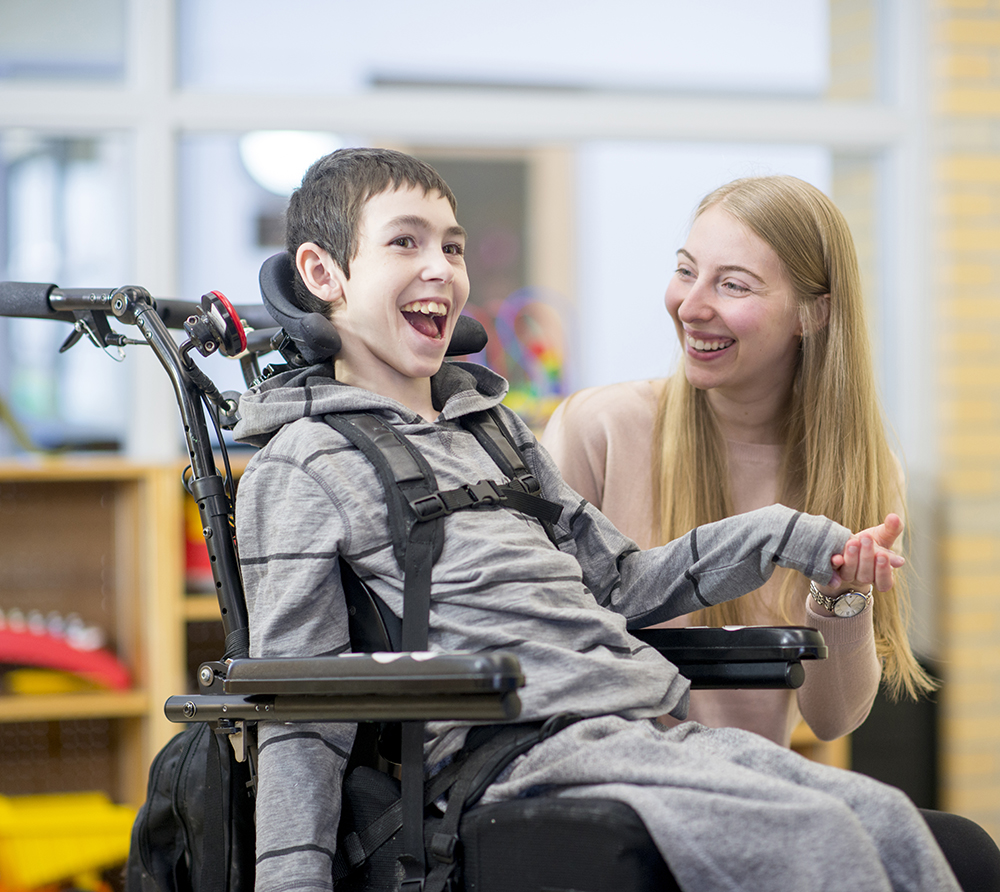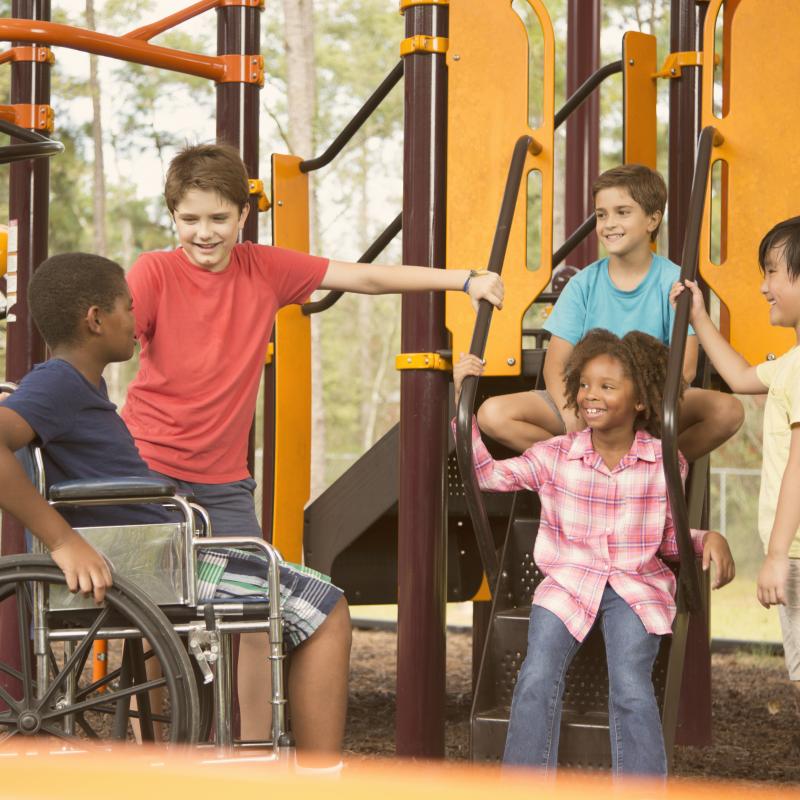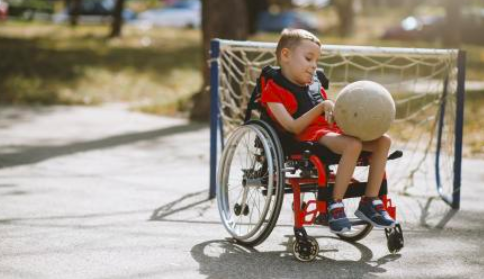Attending to Ableism in Physical Education

Previously published in Volume 87, Issue 4
What is Ableism?
Ableism is a pervasive system of discrimination and exclusion that oppresses people who have mental, emotional, and/or physical disabilities (Tripp et al., 2007).
Persons with disabilities are seen as inferior to able-bodied persons due to societal assumptions about health, productivity, social currency, and beauty. An ableist view suggests able-bodied individuals are normal and even superior, while peoples with disabilities are lesser, or ugly.
Physical Education from the Student’s (with Physical Disabilities) Point of View
Physical education teachers must give students with physical disabilities a platform to discuss their honest experiences—both good and bad—surrounding general physical education. In allowing students with physical disabilities to advocate for their needs and communicate what isn’t working, teachers can move closer to creating an appropriately implemented inclusive physical education environment. If this is accomplished successfully, it could create a positive impact on the social skills, attitudes, and awareness of all students (Haegele & Sutherland, 2015). Here, I offer perspectives of students with physical disabilities on four fronts: positive peer interactions; negative peer interactions; the teacher; and inclusion and exclusion. The term “perspective” is used here to refer to the interpretations and reflections that students with disabilities assign to their own experiences (Haegele & Sutherland, 2015).

Positive Peer Interactions
The gymnasium is an inherently social environment where one’s ability to perform is front and centre. The development of friendships, which are achieved through positive social interactions between students, is essential to positive physical educational experiences.
- Supportive interactions include and involve everyone. The result of an inclusive environment is a sense of belonging, which relies heavily on individual perspectives, and is driven by students.
- Consensual support is also considered important by students with disabilities, as they may not always want help performing activities. Students with disabilities have described the importance of peers asking whether or not assistance was needed prior to supplying it (Haegele & Sutherland, 2015).
Negative Peer Interactions
Negative social comparisons, social isolation, and bullying contribute to negative social experiences during physical education lessons which then can be carried into other classrooms and other social settings.
- Bullying is present in the lives of a large majority of individuals with disabilities (Haegele & Sutherland, 2015). The physical education classroom is an environment where name calling, laughing, social isolation, and physical harm can permeate into the inherent competition of sport.
- When students of all abilities are continuously compared to one another, students with physical disabilities are often pushed to the sidelines by their able-bodied peers. This can lead to deficit thinking, where a person hears something so often they believe it to be true, and give up.
The Teacher
As physical education teachers, we must see our students for what they can do, build our lessons upon this knowledge, and make sure students gain a sense of competence and confidence. For physical education to be truly inclusive, teachers must look beyond the common perception of physical disabilities.
- The literature attending to the personal narratives and perspectives of students with physical disabilities offers evidence of the need to ensure a sense of belonging (Fitzgerald & Stride, 2012; Goodwin & Watkinson, 2000; Haegele & Sutherland, 2015).
- The teacher is responsible for creating and maintaining a positive social climate. A sense of belonging is rooted in the social climate, and a positive climate is even more crucial for students with physical disabilities (Goodwin & Watkinson, 2000; Tripp et al., 2007).
- Supportive language and interactions can lead to a greater sense of inclusion and competence, since students with physical disabilities tend to have more social interaction with teacher aides or teachers than with their same-age peers (Haegele & Sutherland, 2015).

Inclusion and Exclusion
In Haegele and Sutherland’s (2015) review of 13 published qualitative inquiries, they found three major sub-themes related to inclusion and exclusion. Forced exclusion has been perceived by students with physical disabilities as being excluded from the lesson due to external means. Examples of forced exclusion include exclusionary instructional spaces, physical barriers, (inaccessible) events, and types of activities. Forced inclusion is presenting students with little to no choice but to participate. Goodwin and Watkinson (2000) suggest that when students with disabilities participate in activities that are not adapted for their needs, others create standards of acceptable performance in activities. These standards can lead to the perception that students with disabilities cannot meet pre-specified levels of performance that are socially constructed by peers or teachers. Self-exclusion is when the student purposely excludes themself from the lesson. Justifications for self-removal include a fear of being injured, sensory issues, and the difference in ability between students with disabilities and typically developing peers (Haegele & Sutherland, 2015). Typically, when a student with physical disabilities feels left out through either forced inclusion or forced exclusion, they will then self-exclude themselves as a result.
An Inclusive Possibility: Introducing Parasports as Disability Games and Sports
Traditional teaching reinforces traditional outcomes. For change to occur, a shift in planning and reflection of the teaching practice must be ongoing and purposeful. It is our role as physical education teachers to be creative and brave in assuming a new inclusive environment. We might see disability games and sports as a productive avenue for teaching all students. We can take advantage of the opportunity to use disability games and sports as a means for promoting social inclusion and equal opportunity in ways that celebrate ability rather than disability (Grenier & Kearns, 2012).
One way to introduce disability games and sports into physical education is through parasports. Any integration of a parasport unit to be effective should be deliberately planned and sustained over a period of time. Parasports may be introduced in the middle of the school year as it is beneficial for relationships between teacher-pupil and pupil-pupil to have formed. Therefore, the learning environment, behavioural expectations, and routines are established before beginning any parasports unit (Davis et al., 2012). Additionally, the physical education teacher should consciously emphasize the skills and strategies required to play parasports, rather than focusing on a specific disability (Davis et al., 2012). Always keep in mind the opportunity to use parasport as a means for promoting social inclusion and equal opportunity in ways that celebrate ability rather than disability (Grenier & Kearns, 2012).
Including disability games and sports—including parasports—in a physical education program provides complementary skills to students while delivering a powerful message about what it means to be an athlete with a disability (Grenier & Kearns, 2012). They allow students to experience how individuals with disabilities participate in competitive play. However, this occurs only when parasports are presented to students as sports designed for everyone, rather than sports meant for disabled populations (Davis et al., 2012). Inclusion can be promoted through parasports, as they provide the common ground for creating equal-status relationships in the gymnasium. Including parasports in physical education has the potential to unite students of all abilities through successful participation. Having students engage in shared experiences that promote skill development, equipment comprehension, and tactical knowledge specific to sporting experiences can improve the social climate of the school and community and can lead to positive changes in the learning environment (Grenier & Kearns, 2012).
Physical education teachers might utilize videos, interviews, or in-person visits in an effort to offer real-life examples of successful parasport athletes (e.g., Greg Westlake of the Canadian Paralympic sledge hockey team discussing his disabilities and what led him to play the sport:
For young students, this can be a defining moment that can help them understand just how similar they are to the paralympic athletes.
A parasport unit is one way to develop a more inclusive physical education program that can affect student learning and potentially reduce the stigma often associated with having a disability—all while providing opportunities for peer-to-peer teaching and learning that will help improve the instructional, managerial, and social task system in the gymnasium. The result of an inclusive environment is a sense of belonging, which all students benefit from.
Some helpful parasport resources include:
- Goalball: https://paralympic.ca/paralympic-sports/goalball and www.paralympic.org/sites/default/files/document/120305112945504_Card_3_Goalball.pdf
- Seated Volleyball: https://www.paralympic.org/sites/default/files/document/120305113023241_Card_4_Sitting_Volleyball.pdf and https://volleyball.ca/en/about/history/paravolley
- Wheelchair Basketball: https://www.wheelchairbasketball.ca/programs/schools-program/ and https://www.wheelchairbasketball.ca/the-sport/about-the-sport/
- Ice Sledge Hockey: https://www.paralympic.org/sites/default/files/document/120305113234874_Card_7_Winter_Sport.pdf and https://www.hockeyalberta.ca/uploads/source/Sledge/Sledge_Hockey_Coaching_Resource.pdf
A Cautionary Note about Simulations
As teachers we must proceed with caution when including simulations in our lessons. The intention is not to simulate activities to make individuals without disabilities understand the experience of having a disability (Grenier & Kearns, 2012). The use of scooters, blindfolds, wheelchairs, et cetera, does not capture the range and diversity of physical disabilities, nor the lived and embodied experiences of people with physical disabilities (Maher et al., 2019). I have proposed the inclusion of parasports into general physical education settings; however, it is important to remember these experiences are anchored in and through our lives as able-bodied people (Maher et al., 2019). It is important that simulations do not result in able-bodied students speaking and acting for people with disabilities. If the goal is to create a truly inclusive environment, then the ethical dilemma that simulations propose cannot be ignored. Situations where students think and claim to know what it is like to live the life of a peer with a physical disability is problematic.
Concluding Comments
As classrooms continue to diversify, teachers must pursue new and creative ways for physical education to be truly inclusive. Teachers must look beyond the common perception of disability and think about physical education as a diverse community of learners with various skill levels (Tripp et al., 2007). Physical education teachers must examine their own learning environment and consider instructional, managerial, and social task systems in their lessons. We must not lose sight of the overall commitment towards removing barriers in providing opportunities for physical activity and social interaction for students of all abilities. Removing practices that do not work is not limited to physical barriers to participation but can include our own attitudes and perspectives that affect our teaching practices.
References
Davis, R., Rocco-Dillon, S., Grenier, M., Martinez, D., & Aenchbacker, A. (2012). Implementing disability sports in the general physical education curriculum. Journal of Physical Education, Recreation & Dance, 83(5), 35–41. https://doi.org/10.1080/07303084.2012.10598778
Fitzgerald, H., & Stride, A. (2012). Stories about physical education from young people with disabilities. International Journal of Disability, Development and Education, 59(3), 283–293. https://doi.org/10.1080/1034912x.2012.697743
Goodwin, D. L., & Watkinson, E. J. (2000). Inclusive physical education from the perspective of students with physical disabilities. Adapted Physical Activity Quarterly, 17(2), 144–160. https://doi.org/10.1123/apaq.17.2.144
Grenier, M., & Kearns, C. (2012). The benefits of implementing disability sports in physical education. Journal of Physical Education, Recreation & Dance, 83(4), 23–27. https://doi.org/10.1080/07303084.2012.10598758
Haegele, J. A., & Sutherland, S. (2015). Perspectives of students with disabilities toward physical education: A qualitative inquiry review. Quest, 67(3), 255–273. https://doi.org/10.1080/00336297.2015.1050118
Maher, A. J., Williams, D., & Sparkes, A. C. (2019). Teaching non-normative bodies: Simulating visual impairments as embodied pedagogy in action. Sport, Education and Society, 25(5), 530–542. https://doi.org/10.1080/13573322.2019.1617127
Tripp, A., Rizzo, T. L., & Webbert, L. (2007). Inclusion in physical education. Journal of Physical Education, Recreation & Dance, 78(2), 32–48. https://doi.org/10.1080/07303084.2007.10597971








